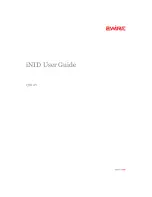
Chapter 1: Configuration
Configuring IP and Ethernet interfaces
Page
1-60
PPPoE page of SM
Applicable products
PMP:
SM
Point-to-Point Protocol over Ethernet (PPPoE) is a protocol that encapsulates PPP frames inside
Ethernet frames (at Ethernet speeds). Benefits to the network operator may include
•
Access control
•
Service monitoring
•
Generation of statistics about activities of the customer
•
Re-use of infrastructure and operational practices by operators who already use PPP for other
networks
PPPoE options are configurable for the SM only, and the AP indicates whether or not PPPoE is enabled
for a specific subscriber.
When PPPoE is enabled, once the RF session comes up between the SM and the AP, the SM will
immediately attempt to connect to the PPPoE Server. You can monitor the status of this by viewing the
PPPoE Session Log in the Logs section (Administrator only). Every time the RF session comes up, the
SM will check the status of the link and if it is down, the SM will attempt to redial the link if necessary
depending on the Timer Type. Also, on the Configuration page, the user may ‘Connect’ or ‘Disconnect’
the session manually. This can be used to override the session to force a manual disconnect and/or
reconnect if there is a problem with the session.
In order to enable PPPoE, NAT MUST be enabled on the SM and Translation Bridging MUST be disabled
on the AP. These items are strictly enforced for you when you are trying to enable PPPoE. A message
will indicate any prerequisites not being met. Also, the NAT Public IP DHCP client cannot be enabled,
because the NAT Public IP is received through the IPCP process of the PPPoE discovery stages.
The pre-requisites are:
•
NAT MUST be enabled on the SM
o
NAT DHCP Client is disabled automatically. The NAT public IP is received from the
PPPoE Server.
o
NAT Public Network Interface Configuration will not be used and must be left to
defaults. Also NAT Public IP DHCP is disabled if it is enabled.
•
Translation Bridging MUST be DISABLED on the AP
o
This will only be determined if the SM is in session since the SM won’t know the AP
configuration otherwise. If the SM is not in session, PPPoE can be enabled but if the
SM goes into session to a Translation Bridge-enabled AP, then PPPoE will not be
enabled.
Summary of Contents for PMP 450 AP
Page 51: ...Chapter 1 Configuration Quick link setup Page 1 23 ...
Page 155: ...Chapter 1 Configuration Configuring security Page 1 127 ...
Page 163: ...Chapter 1 Configuration Configuring security Page 1 135 ...
Page 164: ...Chapter 1 Configuration Configuring security Page 1 136 ...
Page 193: ...Chapter 1 Configuration Configuring radio parameters Page 1 165 ...
Page 194: ...Chapter 1 Configuration Configuring radio parameters Page 1 166 ...
Page 195: ...Chapter 1 Configuration Configuring radio parameters Page 1 167 ...
Page 206: ...Chapter 1 Configuration Configuring radio parameters Page 1 178 ...
Page 210: ...Chapter 1 Configuration Configuring radio parameters Page 1 182 ...
Page 636: ...Chapter 5 Troubleshooting Logs Page 5 16 Figure 95 SM Authorization log ...
















































